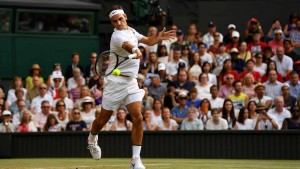No, not the animal. GOAT – greatest of all time. Roger Federer? While he has now won eight Wimbledon titles and 19 majors overall, he may be a contender. It’s hard to imagine him self-labeling as GOAT. I don’t know him, of course, but he doesn’t seem the egotistical type.
(ATP World Tour photo)
The most famous of all should be Muhammad Ali, the boxer, not the Egyptian khedive (for those of you who are history-minded). Ali appears to have first used this phrase to describe himself, though not necessarily the acronym which seems to be a more recent phenomenon.
Full disclosure: I hate boxing. However, I was thoroughly engrossed in David Remnick’s 1998 partial biography King of the World: Muhammad Ali and the Rise of an American Hero. It’s more of a social history – my favourite – than a boxing tale though it certainly does have some colourful descriptions of his most famous matches with Sonny Liston and Floyd Patterson. Much in the same vein as Ken Burns’s documentaries Jazz and Baseball opened the door on segregation in the US, especially in the northern states where one might not have expected it to be so strong, King of the World reveals the boxing world of early to mid-1960s in its all its grittiness. In today’s parlance, we might say it was a highly racialized playing field. Ali, with his ties to the Nation of Islam (or Black Muslims as they were derisively known by Ali’s critics), was a crucial figure in trying to recast the Black boxer as an independent figure. Not the white man’s Black man, not the Black civil rights integrationist hero.
Since Ali died in 2016 there have been many tributes and documentaries that have portrayed him as the ultimate American hero, most notably as the final torch bearer at the 1996 Atlanta Olympic Games opening ceremony. However, it’s important to remember that he wasn’t always perceived as a hero by the American public, thus the “rise of an American hero” in Remnick’s title. Because he associated with Malcolm X (before breaking off ties with him as per Nation of Islam leader Elijah Muhammad’s wishes), because he out-rightly expressed his desire not to integrate but to remain separate, at this stage of his career Ali faced a huge public backlash. Certain sports columnists refused to even refer to him as Muhammad Ali.
At least at the stage of his career highlighted in this book, Ali was a complicated character, at once a professional athlete with excellent training habits and a fast-talking provocative player with a mouth as big as his talent.
I urge readers to pick up the book and find out for themselves what Ali – one of the world’s most celebrated heroes – was really like. It won’t hurt that Remnick, New Yorker editor, is a fabulous writer.
